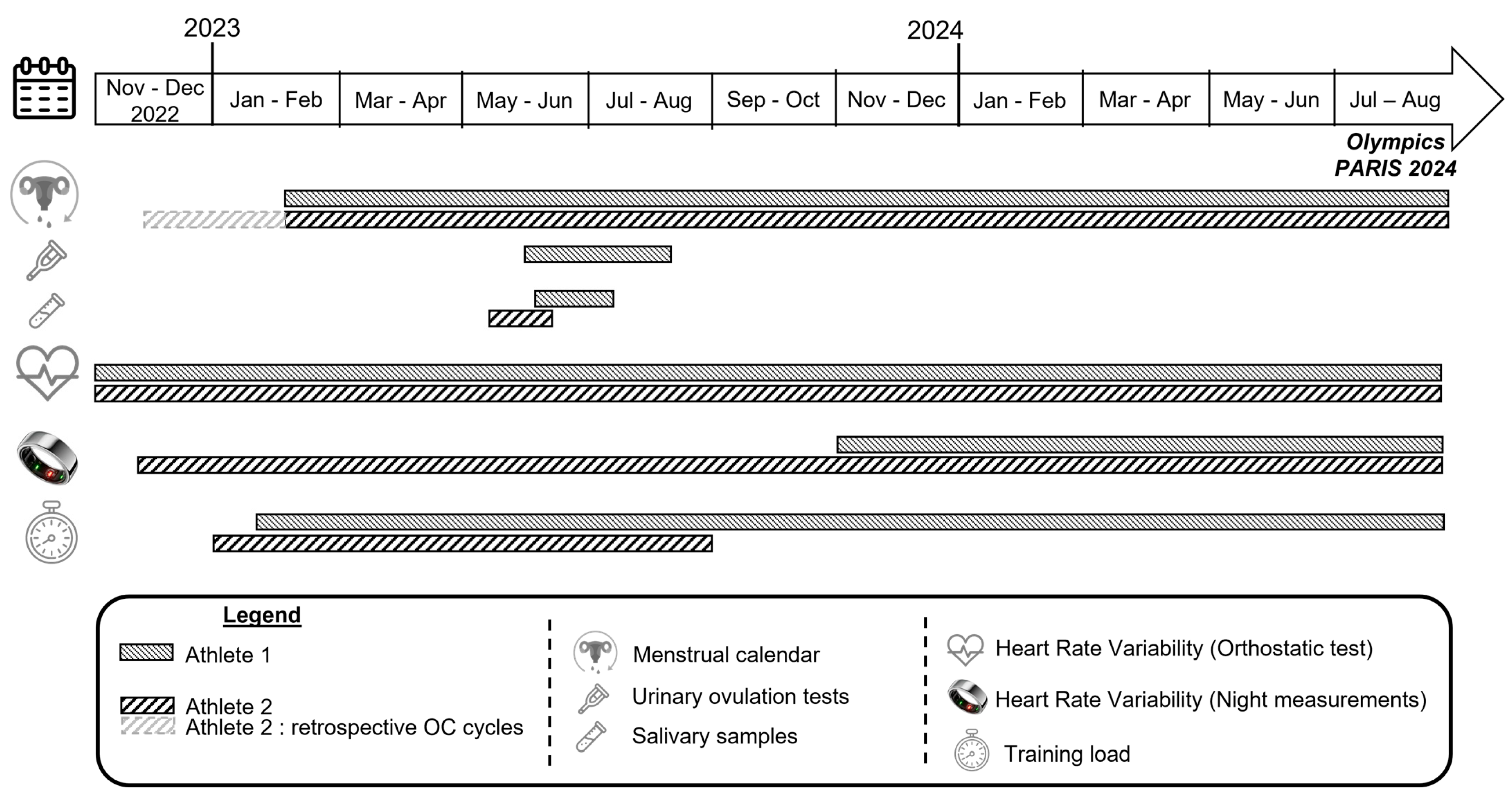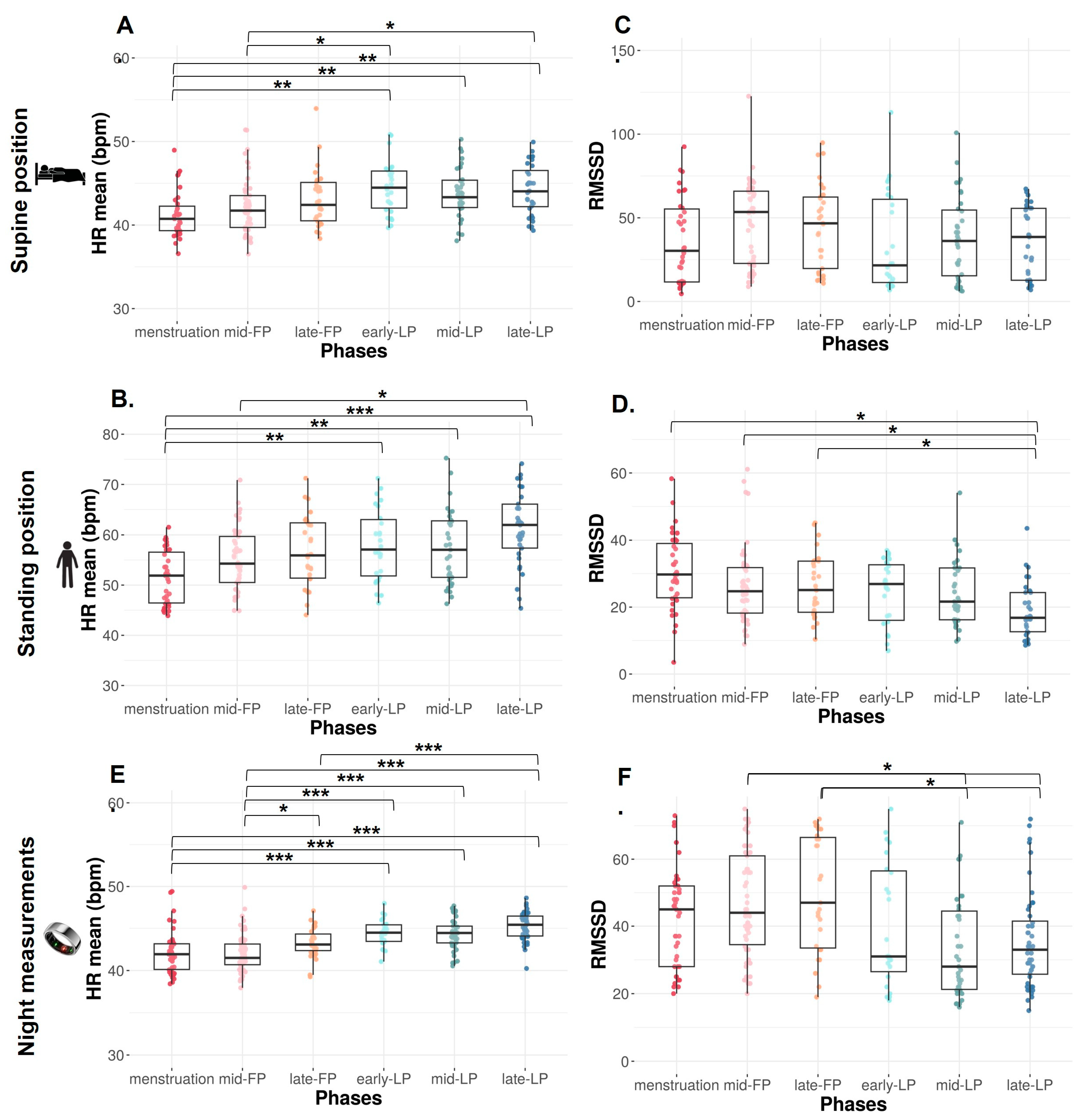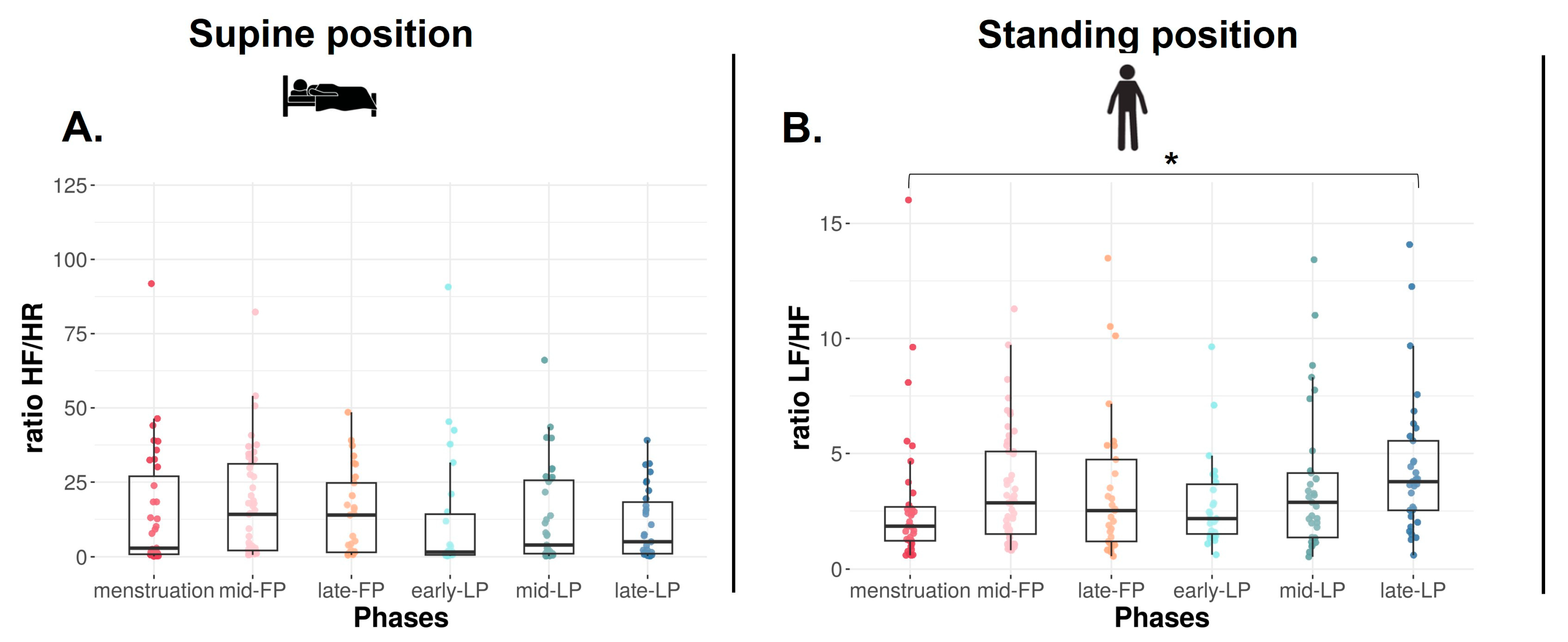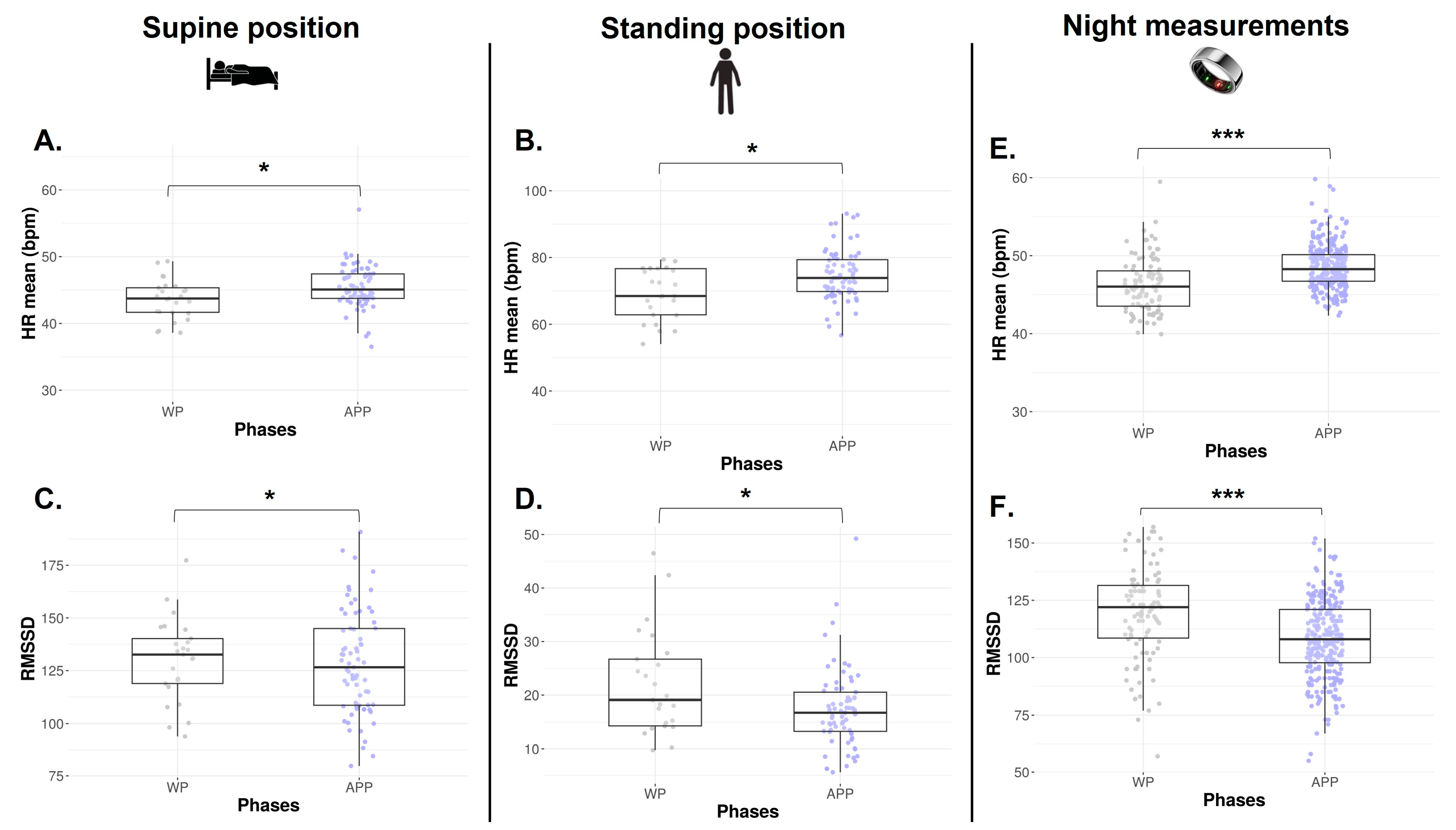Heart Rate Variability Measurements Across the Menstrual Cycle and Oral Contraceptive Phases in Two Olympian Female Swimmers: A Case Report
Abstract
1. Introduction
2. Materials and Methods
2.1. Subjects
2.2. Study Design
2.3. HRV Monitoring
2.3.1. Orthostatic Test (HRV After Awakening)
2.3.2. Night Measurements
2.4. Menstrual Status Monitoring and Phase Determination
2.5. Training Load
2.6. Statistical Analysis
3. Results
3.1. Athlete 1
3.1.1. Menstrual Cycle
3.1.2. Training Load
3.1.3. Orthostatic Awaking Test
3.1.4. Night Measurements
3.2. Athlete 2
3.2.1. Oral Contraceptive Use
3.2.2. Training Load
3.2.3. Orthostatic Awaking Test
3.2.4. Night Measurements
4. Discussion
5. Conclusions
Supplementary Materials
Author Contributions
Funding
Institutional Review Board Statement
Informed Consent Statement
Data Availability Statement
Acknowledgments
Conflicts of Interest
Abbreviations
| ANS | Autonomous Nervous System |
| APP | Active Pill Phase |
| E2 | Estradiol |
| FP | Follicular Phase |
| HRV | Heart Rate Variability |
| HR | Heart Rate |
| LF | Low Frequency |
| LP | Luteal Phase |
| MC | Menstrual Cycle |
| OC | Oral Contraception |
| P4 | Progesterone |
| RMSSD | Root Mean Square of Successive Difference |
| RPE | Rating of Perceived Exertion |
| sRPE | Rating of Perceived Exertion of the Session |
| SDNN | Standard Deviation of NN intervals |
| ST | Standing |
| SU | Supine |
| WP | Withdrawal Pill |
References
- Plews, D.J.; Laursen, P.B.; Stanley, J.; Kilding, A.E.; Buchheit, M. Training Adaptation and Heart Rate Variability in Elite Endurance Athletes: Opening the Door to Effective Monitoring. Sports Med. 2013, 43, 773–781. [Google Scholar] [CrossRef] [PubMed]
- Bourdillon, N.; Bellenoue, S.; Schmitt, L.; Millet, G.P. Daily Cardiac Autonomic Responses during the Tour de France in a Male Professional Cyclist. Front. Neurosci. 2024, 17, 1221957. [Google Scholar] [CrossRef] [PubMed]
- Schmitt, L.; Hellard, P.; Millet, G.P.; Roels, B.; Richalet, J.P.; Fouillot, J.P. Heart Rate Variability and Performance at Two Different Altitudes in Well-Trained Swimmers. Int. J. Sports Med. 2006, 27, 226–231. [Google Scholar] [CrossRef][Green Version]
- Pla, R.; Aubry, A.; Resseguier, N.; Merino, M.; Toussaint, J.-F.; Hellard, P. Training Organization, Physiological Profile and Heart Rate Variability Changes in an Open-Water World Champion. Int. J. Sports Med. 2019, 40, 519–527. [Google Scholar] [CrossRef]
- Schmitt, L.; Regnard, J.; Auguin, D.; Millet, G.P. Monitoring Training and Fatigue with Heart Rate Variability: Case Study in a Swimming Olympic Champion. J. Fit. Res. 2016, 5, 38–45. [Google Scholar]
- Flatt, A.A.; Esco, M.R.; Nakamura, F.Y. Association between Subjective Indicators of Recovery Status and Heart Rate Variability among Divison-1 Sprint-Swimmers. Sports 2018, 6, 93. [Google Scholar] [CrossRef]
- Manresa-Rocamora, A.; Sarabia, J.M.; Javaloyes, A.; Flatt, A.A.; Moya-Ramón, M. Heart Rate Variability-Guided Training for Enhancing Cardiac-Vagal Modulation, Aerobic Fitness, and Endurance Performance: A Methodological Systematic Review with Meta-Analysis. Int. J. Environ. Res. Public Health 2021, 18, 10299. [Google Scholar] [CrossRef]
- Carrasco-Poyatos, M.; González-Quílez, A.; Altini, M.; Granero-Gallegos, A. Heart Rate Variability-Guided Training in Professional Runners: Effects on Performance and Vagal Modulation. Physiol. Behav. 2022, 244, 113654. [Google Scholar] [CrossRef]
- Carrasco-Poyatos, M.; González-Quílez, A.; Martínez-González-Moro, I.; Granero-Gallegos, A. HRV-Guided Training for Professional Endurance Athletes: A Protocol for a Cluster-Randomized Controlled Trial. Int. J. Environ. Res. Public Health 2020, 17, 5465. [Google Scholar] [CrossRef]
- Schmitt, L.; Regnard, J.; Coulmy, N.; Millet, G.P. Influence of Training Load and Altitude on Heart Rate Variability Fatigue Patterns in Elite Nordic Skiers. Int. J. Sports Med. 2018, 39, 773–781. [Google Scholar] [CrossRef]
- Plews, D.J.; Laursen, P.B.; Kilding, A.E.; Buchheit, M. Heart-Rate Variability and Training-Intensity Distribution in Elite Rowers. Int. J. Sports Physiol. Perform. 2014, 9, 1026–1032. [Google Scholar] [CrossRef] [PubMed]
- Stanley, J.; D’Auria, S.; Buchheit, M. Cardiac Parasympathetic Activity and Race Performance: An Elite Triathlete Case Study. Int. J. Sports Physiol. Perform. 2015, 10, 528–534. [Google Scholar] [CrossRef] [PubMed]
- Altini, M.; Plews, D. What Is behind Changes in Resting Heart Rate and Heart Rate Variability? A Large-Scale Analysis of Longitudinal Measurements Acquired in Free-Living. Sensors 2021, 21, 7932. [Google Scholar] [CrossRef] [PubMed]
- Schmalenberger, K.M.; Eisenlohr-Moul, T.A.; Würth, L.; Schneider, E.; Thayer, J.F.; Ditzen, B.; Jarczok, M.N. A Systematic Review and Meta-Analysis of Within-Person Changes in Cardiac Vagal Activity across the Menstrual Cycle: Implications for Female Health and Future Studies. J. Clin. Med. 2019, 8, 1946. [Google Scholar] [CrossRef]
- Schmalenberger, K.M.; Eisenlohr-Moul, T.A.; Jarczok, M.N.; Eckstein, M.; Schneider, E.; Brenner, I.G.; Duffy, K.; Schweizer, S.; Kiesner, J.; Thayer, J.F.; et al. Menstrual Cycle Changes in Vagally-Mediated Heart Rate Variability Are Associated with Progesterone: Evidence from Two Within-Person Studies. J. Clin. Med. 2020, 9, 617. [Google Scholar] [CrossRef]
- Elliott-Sale, K.J.; Minahan, C.L.; de Jonge, X.A.K.J.; Ackerman, K.E.; Sipilä, S.; Constantini, N.W.; Lebrun, C.M.; Hackney, A.C. Methodological Considerations for Studies in Sport and Exercise Science with Women as Participants: A Working Guide for Standards of Practice for Research on Women. Sports Med. 2021, 51, 843–861. [Google Scholar] [CrossRef]
- Prado, R.C.R. Comment on “Challenging Aspects of Research on the Influence of the Menstrual Cycle and Oral Contraceptives on Physical Performance”. Sports Med. 2023, 53, 927–929. [Google Scholar] [CrossRef]
- Stadler, A.; Weidlinger, S.; Stute, P. Impact of Endogenous and Exogenous Progesterone Exposure on Stress Biomarkers: A Systematic Review. Climacteric 2019, 22, 435–441. [Google Scholar] [CrossRef]
- Brown, N.; Roldan-Reoyo, O.; Williams, G.K.R.; Stodter, A.; Moore, I.S.; Mackintosh, K.A.; McNarry, M.A.; Williams, E.M.P. Profiling Hormonal Contraceptive Use and Perceived Impact on Training and Performance in a Global Sample of Women Rugby Players. Int. J. Sports Physiol. Perform. 2023, 18, 937–943. [Google Scholar] [CrossRef]
- Wilczak, A.; Marciniak, K.; Kłapciński, M.; Rydlewska, A.; Danel, D.; Jankowska, E.A. Relations between Combined Oral Contraceptive Therapy and Indices of Autonomic Balance (Baroreflex Sensitivity and Heart Rate Variability) in Young Healthy Women. Ginekol. Pol. 2013, 84, 915–921. [Google Scholar] [CrossRef]
- Sims, S.T.; Ware, L.; Capodilupo, E.R. Patterns of Endogenous and Exogenous Ovarian Hormone Modulation on Recovery Metrics across the Menstrual Cycle. BMJ Open Sport Exerc. Med. 2021, 7, e001047. [Google Scholar] [CrossRef] [PubMed]
- Teixeira, A.L.; Ramos, P.S.; Vianna, L.C.; Ricardo, D.R. Heart Rate Variability across the Menstrual Cycle in Young Women Taking Oral Contraceptives. Psychophysiology 2015, 52, 1451–1455. [Google Scholar] [CrossRef] [PubMed]
- Aubert, A.E.; Seps, B.; Beckers, F. Heart Rate Variability in Athletes. Sports Med. 2003, 33, 889–919. [Google Scholar] [CrossRef] [PubMed]
- Schmitt, L.; Regnard, J.; Millet, G.P. Monitoring Fatigue Status with HRV Measures in Elite Athletes: An Avenue Beyond RMSSD? Front. Physiol. 2015, 6, 343. [Google Scholar] [CrossRef]
- Bourdillon, N.; Schmitt, L.; Yazdani, S.; Vesin, J.-M.; Millet, G.P. Minimal Window Duration for Accurate HRV Recording in Athletes. Front. Neurosci. 2017, 11, 456. [Google Scholar] [CrossRef]
- McKay, A.K.A.; Stellingwerff, T.; Smith, E.S.; Martin, D.T.; Mujika, I.; Goosey-Tolfrey, V.L.; Sheppard, J.; Burke, L.M. Defining Training and Performance Caliber: A Participant Classification Framework. Int. J. Sports Physiol. Perform. 2022, 17, 317–331. [Google Scholar] [CrossRef]
- Antero, J.; Golovkine, S.; Niffoi, L.; Meignié, A.; Chassard, T.; Delarochelambert, Q.; Duclos, M.; Maitre, C.; Maciejewski, H.; Diry, A.; et al. Menstrual Cycle and Hormonal Contraceptive Phases’ Effect on Elite Rowers’ Training, Performance and Wellness. Front. Physiol. 2023, 14, 1110526. [Google Scholar] [CrossRef]
- Dupuit, M.; Meignié, A.; Chassard, T.; Blanquet, L.; LeHeran, J.; Bernardeau, E.; Delaunay, T.; Toussaint, J.-F.; Duclos, M.; Antero, J. On-Field Methodological Approach to Monitor the Menstrual Cycle and Hormonal Phases in Elite Female Athletes. Int. J. Sports Physiol. Perform. 2023, 18, 1169–1178. [Google Scholar] [CrossRef]
- Carlin, H.; Dupuit, M.; Storme, F.; Chassard, T.; Meignié, A.; Sachet, I.; Brunet, E.; Toussaint, J.-F.; Antero, J. Impact of Menstrual Cycle or Combined Oral Contraception on Elite Female Cyclists’ Training Responses through a Clustering Analysis of Training Sessions. Front. Sports Act. Living 2024, 6, 1307436. [Google Scholar] [CrossRef]
- Delarochelambert, Q.; Hamri, I.; Chassard, T.; Meignié, A.; Dupuit, M.; Storme, F.; Diry, A.; Toussaint, J.-F.; Louis, P.-Y.; Coulmy, N.; et al. Exploring the Effect of the Menstrual Cycle or Oral Contraception on Elite Athletes’ Training Responses When Workload Is Not Objectively Quantifiable: The MILS Approach and Findings from Female Olympians. BMJ Open Sport Exerc. Med. 2024, 10, e001810. [Google Scholar] [CrossRef]
- Lafitte, A.; Dupuit, M.; Chassard, T.; Barlier, K.; Badier, N.; Duclos, M.; Toussaint, J.-F.; Antero, J.d.S. Original Salivary Sex Hormone Data of Naturally Menstruating Athletes and Hormonal Contraceptive Users. BMJ Open Sport Exerc. Med. 2024, 10, e002078. [Google Scholar] [CrossRef] [PubMed]
- Badier, N.; Dupuit, M.; Dormion, G.; Chassard, T.; Barlier, K.; Lafitte, A.; Delrieu, L.; Toussaint, J.-F.; Antero, J. Cyclical Physiology of Elite Female Athletes: Longitudinal Quantification of Wellness Parameters Considering Menstrual, Weekly, and Seasonal Variations. Appl. Sci. 2025, 15, 1357. [Google Scholar] [CrossRef]
- Schmitt, L.; Regnard, J.; Desmarets, M.; Mauny, F.; Mourot, L.; Fouillot, J.-P.; Coulmy, N.; Millet, G. Fatigue Shifts and Scatters Heart Rate Variability in Elite Endurance Athletes. PLoS ONE 2013, 8, e71588. [Google Scholar] [CrossRef] [PubMed]
- Kinnunen, H.; Rantanen, A.; Kenttä, T.; Koskimäki, H. Feasible Assessment of Recovery and Cardiovascular Health: Accuracy of Nocturnal HR and HRV Assessed via Ring PPG in Comparison to Medical Grade ECG. Physiol. Meas. 2020, 41, 04NT01. [Google Scholar] [CrossRef]
- Schaumberg, M.A.; Jenkins, D.G.; Janse de Jonge, X.A.K.; Emmerton, L.M.; Skinner, T.L. Three-Step Method for Menstrual and Oral Contraceptive Cycle Verification. J. Sci. Med. Sport 2017, 20, 965–969. [Google Scholar] [CrossRef]
- Pauerstein, C.J.; Eddy, C.A.; Croxatto, H.D.; Hess, R.; Siler-Khodr, T.M.; Croxatto, H.B. Temporal Relationships of Estrogen, Progesterone, and Luteinizing Hormone Levels to Ovulation in Women and Infrahuman Primates. Am. J. Obstet. Gynecol. 1978, 130, 876–886. [Google Scholar] [CrossRef]
- Peinado, A.B.; Alfaro-Magallanes, V.M.; Romero-Parra, N.; Barba-Moreno, L.; Rael, B.; Maestre-Cascales, C.; Rojo-Tirado, M.A.; Castro, E.A.; Benito, P.J.; Ortega-Santos, C.P.; et al. Methodological Approach of the Iron and Muscular Damage: Female Metabolism and Menstrual Cycle during Exercise Project (IronFEMME Study). Int. J. Environ. Res. Public Health 2021, 18, 735. [Google Scholar] [CrossRef]
- Collomp, K.; Olivier, A.; Castanier, C.; Bonnigal, J.; Bougault, V.; Buisson, C.; Ericsson, M.; Duron, E.; Favory, E.; Zimmermann, M.; et al. Correlation between Serum and Saliva Sex Hormones in Young Female Athletes. J. Sports Med. Phys. Fit. 2024, 65, 274–278. [Google Scholar] [CrossRef]
- Ferrer, E.; Rodas, G.; Casals, G.; Trilla, A.; Balagué-Dobon, L.; González, J.R.; Ridley, K.; White, R.; Burden, R.J. The Use of Saliva and Blood Progesterone to Profile the Menstrual Cycles of Youth Professional Football Players. Front. Sports Act. Living 2024, 6, 1430158. [Google Scholar] [CrossRef]
- Grant, A.D.; Newman, M.; Kriegsfeld, L.J. Ultradian Rhythms in Heart Rate Variability and Distal Body Temperature Anticipate Onset of the Luteinizing Hormone Surge. Sci. Rep. 2020, 10, 20378. [Google Scholar] [CrossRef]
- Banister, E.W.; Calvert, T.W.; Savage, M.V.; Bach, T. A Systems Model of Training for Athletic Performance. Aust. J. Sports Med. 1975, 7, 57–61. [Google Scholar]
- Haddad, M.; Stylianides, G.; Djaoui, L.; Dellal, A.; Chamari, K. Session-RPE Method for Training Load Monitoring: Validity, Ecological Usefulness, and Influencing Factors. Front. Neurosci. 2017, 11, 612. [Google Scholar] [CrossRef] [PubMed]
- Nuuttila, O.-P.; Kyröläinen, H.; Kokkonen, V.-P.; Uusitalo, A. Morning versus Nocturnal Heart Rate and Heart Rate Variability Responses to Intensified Training in Recreational Runners. Sports Med. Open 2024, 10, 120. [Google Scholar] [CrossRef]
- Besson, C.; Saubade, M.; Gremeaux, V.; Millet, G.P.; Schmitt, L. Analyse de La Variabilité de La Fréquence Cardiaque: Méthodes, Limites et Exemples Cliniques. Rev. Medicale Suisse 2020, 701, 1432–1437. [Google Scholar] [CrossRef]
- Stanley, J.; Halliday, A.; D’Auria, S.; Buchheit, M.; Leicht, A.S. Effect of Sauna-Based Heat Acclimation on Plasma Volume and Heart Rate Variability. Eur. J. Appl. Physiol. 2015, 115, 785–794. [Google Scholar] [CrossRef]
- Le Meur, Y.; Pichon, A.; Schaal, K.; Schmitt, L.; Louis, J.; Gueneron, J.; Vidal, P.P.; Hausswirth, C. Evidence of Parasympathetic Hyperactivity in Functionally Overreached Athletes. Med. Sci. Sports Exerc. 2013, 45, 2061–2071. [Google Scholar] [CrossRef]
- Ahokas, E.K.; Hanstock, H.G.; Löfberg, I.; Nyman, M.; Wenning, P.; Kyröläinen, H.; Mikkonen, R.S.; Ihalainen, J.K. Nocturnal Heart Rate Variability in Women Discordant for Hormonal Contraceptive Use. Med. Sci. Sports Exerc. 2023, 55, 1342–1349. [Google Scholar] [CrossRef]
- Tanaka, M.; Sato, M.; Umehara, S.; Nishikawa, T. Influence of Menstrual Cycle on Baroreflex Control of Heart Rate: Comparison with Male Volunteers. Am. J. Physiol. Regul. Integr. Comp. Physiol. 2003, 285, R1091–R1097. [Google Scholar] [CrossRef]
- Minson, C.T.; Halliwill, J.R.; Young, T.M.; Joyner, M.J. Sympathetic Activity and Baroreflex Sensitivity in Young Women Taking Oral Contraceptives. Circulation 2000, 102, 1473–1476. [Google Scholar] [CrossRef]
- Buchheit, M.; Gindre, C. Cardiac Parasympathetic Regulation: Respective Associations with Cardiorespiratory Fitness and Training Load. Am. J. Physiol. Heart Circ. Physiol. 2006, 291, H451–H458. [Google Scholar] [CrossRef]
- Bellenger, C.R.; Fuller, J.T.; Thomson, R.L.; Davison, K.; Robertson, E.Y.; Buckley, J.D. Monitoring Athletic Training Status Through Autonomic Heart Rate Regulation: A Systematic Review and Meta-Analysis. Sports Med. 2016, 46, 1461–1486. [Google Scholar] [CrossRef] [PubMed]
- Burden, R.J.; Biswas, A.; Hackney, A.C. Female Athlete Sport Science Versus Applied Practice: Bridging the Gap. Int. J. Sports Physiol. Perform. 2024, 19, 1518–1521. [Google Scholar] [CrossRef] [PubMed]
- Cao, R.; Azimi, I.; Sarhaddi, F.; Niela-Vilen, H.; Axelin, A.; Liljeberg, P.; Rahmani, A.M. Accuracy Assessment of Oura Ring Nocturnal Heart Rate and Heart Rate Variability in Comparison With Electrocardiography in Time and Frequency Domains: Comprehensive Analysis. J. Med. Internet Res. 2022, 24, e27487. [Google Scholar] [CrossRef] [PubMed]




| Phases | Menstruation | Mid-FP | Late-FP | Early-LP | Mid-FP | Late-FP | p-Value |
|---|---|---|---|---|---|---|---|
| SU position | |||||||
| SDNN | 41 (25–64) | 52 (37–71) | 58 (38–67) | 31 (19–75) | 45 (28–62) | 44 (25–76) | 0.234 |
| LF (ms2) | 303 (42–902) | 344 (99–796) | 313 (87–775) | 107 (51–570) | 150 (48–544) | 289 (88–512) | 0.267 |
| HF (ms2) | 112 (39–1030) | 576 (93–1245) | 562 (71–1114) | 71 (29–691) | 169 (45–1030) | 270 (50–906) | 0.093 |
| LF+HF (ms2) | 446 (82–1910) | 983 (195–2180) | 924 (168–1676) | 206 (78–1461) | 474 (106–1478) | 542 (142–1432) | 0.157 |
| ST position | |||||||
| SDNN | 55 (45–72) | 52 (43–64) | 59 (46–69) | 60 (37–72) | 49 (39–68) | 48 (35–66) | 0.732 |
| LF (ms2) | 471 (286–788) | 512 (336–798) | 431 (304–801) | 432 (292–650) | 373 (241–768) | 376 (193–722) | 0.391 |
| HF (ms2) | 278 a (128–483) | 206 b (120–309) | 226 c (100–396) | 219 (70–328) | 150 (85–324) | 96 (52–193) | 0.006 |
| LF+HF (ms2) | 844 (415–1311) | 790 (492–1087) | 827 (477–1079) | 702 (461–921) | 696 (355–919) | 530 (250–96) | 0.143 |
| Variables | Phases | Variables | Phases | ||||
|---|---|---|---|---|---|---|---|
| SU Position | WP | APP | p-Value | ST Position | WP | APP | p-Value |
| SDNN | 101 (92–109) | 105 (90–114) | 0.413 | SDNN | 55 (48.02–70.18) | 51 (37–61) | 0.129 |
| LF (ms2) | 1271 (993–1652) | 1471 (995–2195) | 0.411 | LF (ms2) | 723 (486–1151) | 579 (290–887) | 0.041 |
| HF (ms2) | 5309 (4301–6269) | 5306 (3968–6777) | 0.757 | HF (ms2) | 175 (113–361) | 148 (92–228) | 0.127 |
| LF+HF (ms2) | 7012 (5488–8129) | 7243 (4997–8614) | 0.593 | LF+HF (ms2) | 956 (586–1775) | 748 (449–1077) | 0.040 |
| HF/HR | 125 (94–153) | 114 (88–149) | 0.683 | LF/HF | 4 (2–5) | 3 (2–5) | 0.783 |
Disclaimer/Publisher’s Note: The statements, opinions and data contained in all publications are solely those of the individual author(s) and contributor(s) and not of MDPI and/or the editor(s). MDPI and/or the editor(s) disclaim responsibility for any injury to people or property resulting from any ideas, methods, instructions or products referred to in the content. |
© 2025 by the authors. Licensee MDPI, Basel, Switzerland. This article is an open access article distributed under the terms and conditions of the Creative Commons Attribution (CC BY) license (https://creativecommons.org/licenses/by/4.0/).
Share and Cite
Dupuit, M.; Barlier, K.; Tranchard, B.; Toussaint, J.-F.; Antero, J.; Pla, R. Heart Rate Variability Measurements Across the Menstrual Cycle and Oral Contraceptive Phases in Two Olympian Female Swimmers: A Case Report. Sports 2025, 13, 185. https://doi.org/10.3390/sports13060185
Dupuit M, Barlier K, Tranchard B, Toussaint J-F, Antero J, Pla R. Heart Rate Variability Measurements Across the Menstrual Cycle and Oral Contraceptive Phases in Two Olympian Female Swimmers: A Case Report. Sports. 2025; 13(6):185. https://doi.org/10.3390/sports13060185
Chicago/Turabian StyleDupuit, Marine, Kilian Barlier, Benjamin Tranchard, Jean-François Toussaint, Juliana Antero, and Robin Pla. 2025. "Heart Rate Variability Measurements Across the Menstrual Cycle and Oral Contraceptive Phases in Two Olympian Female Swimmers: A Case Report" Sports 13, no. 6: 185. https://doi.org/10.3390/sports13060185
APA StyleDupuit, M., Barlier, K., Tranchard, B., Toussaint, J.-F., Antero, J., & Pla, R. (2025). Heart Rate Variability Measurements Across the Menstrual Cycle and Oral Contraceptive Phases in Two Olympian Female Swimmers: A Case Report. Sports, 13(6), 185. https://doi.org/10.3390/sports13060185






